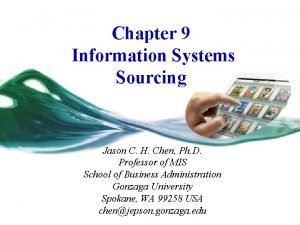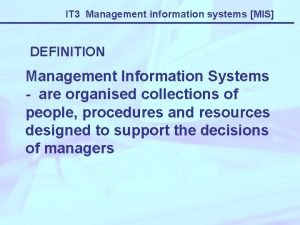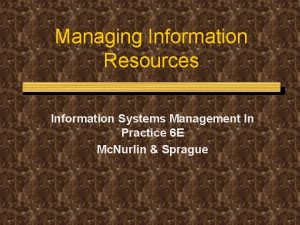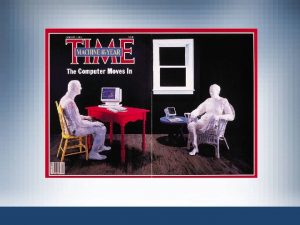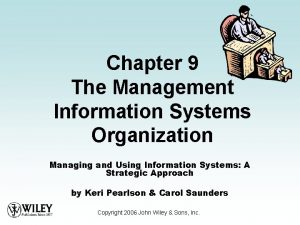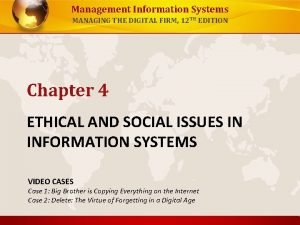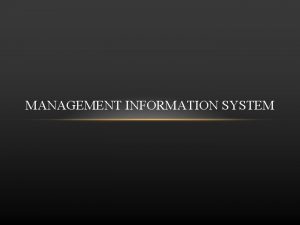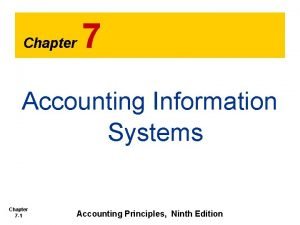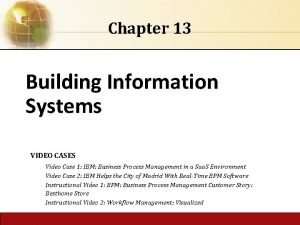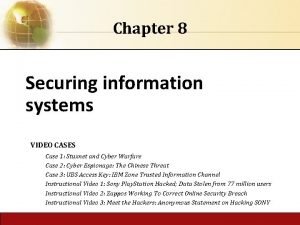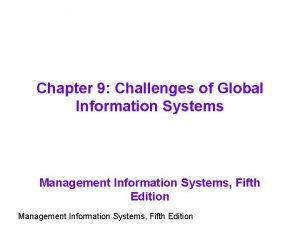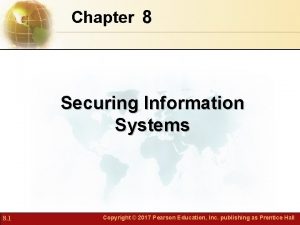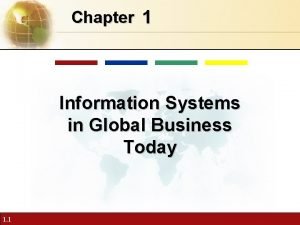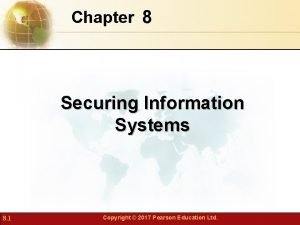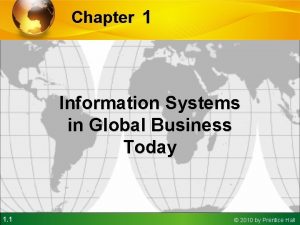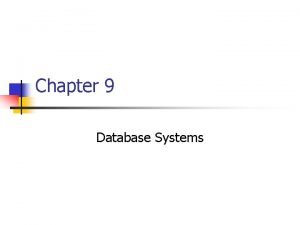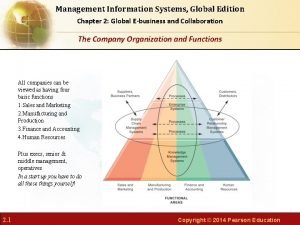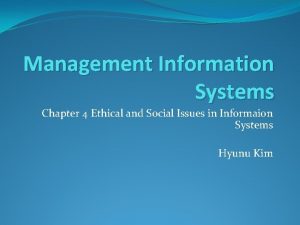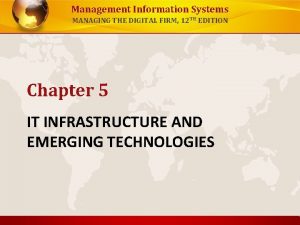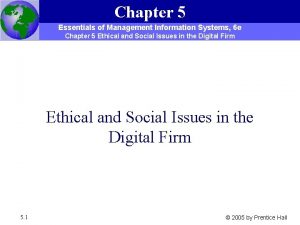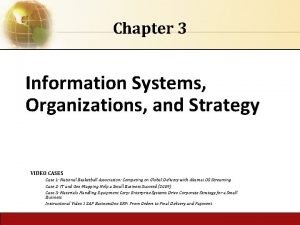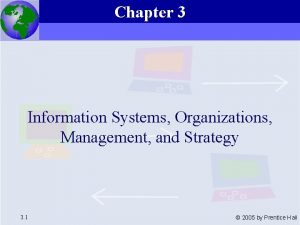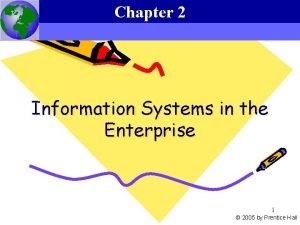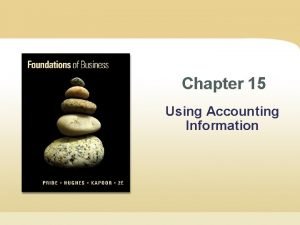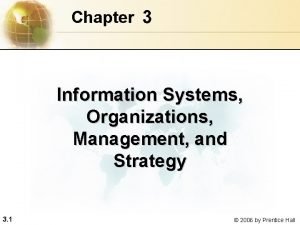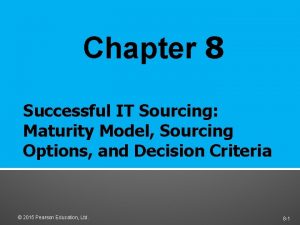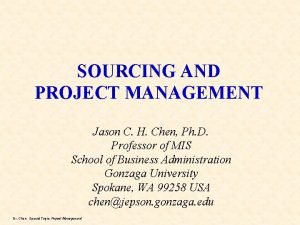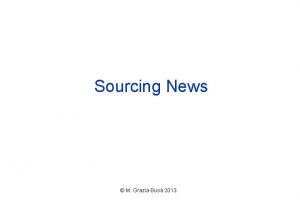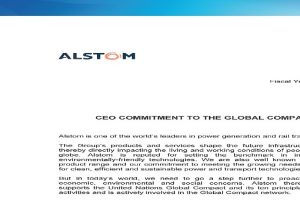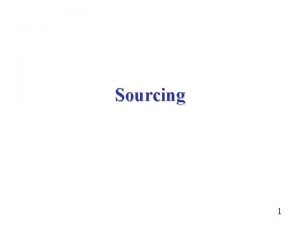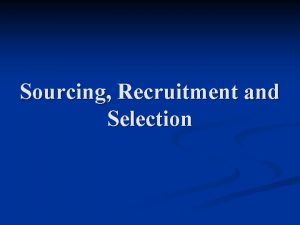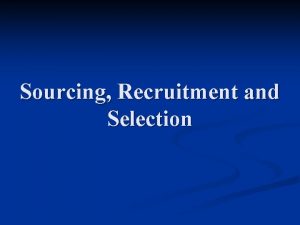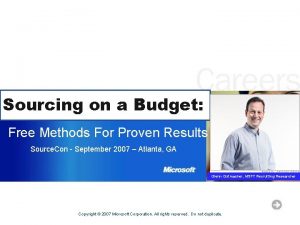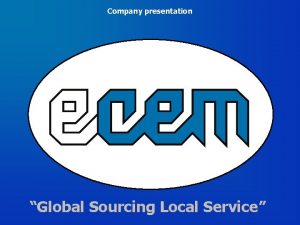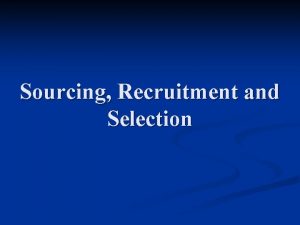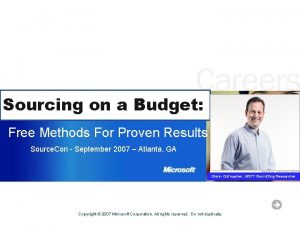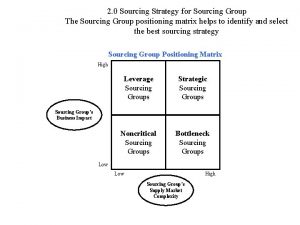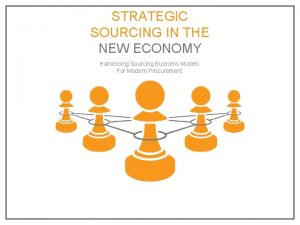Chapter 11 Information Systems Management Sourcing Jason C













































- Slides: 45

Chapter 11 Information Systems Management (Sourcing) Jason C. H. Chen, Ph. D. Professor of MIS School of Business Administration Gonzaga University Spokane, WA 99258 chen@gonzaga. edu Dr. Chen, Management Information Systems

"I Don't Know Anything About Doing Business in India. " • Team discuss outsourcing PRIDE development to India. • Ownership of Ajit Barid (“Invincible Cloud”) not known. • Successfully developed i. OS for i. PAD. • Can they do Android? • Company growing quickly, but is it well managed? • Security, time risks? • Bite the bullet and hire own programmers? Dr. Chen, Management Information Systems

Study Questions Q 1: What are the functions and organization of the IS department? Q 2: How do organizations plan the use of IS? (Information System Strategy Triangle) Q 3: What are the advantages and disadvantages of outsourcing? Q 4: What are your user rights and responsibilities? Q 5: 2026? Dr. Chen, Management Information Systems

Q 1: What Are the Functions and Organization of the IS Department? • Major functions of information systems department v. Plan use of IS to accomplish organizational goals and strategy v. Manage outsourcing relationships v. Protect information assets v. Develop, operate, and maintain organization’s computing infrastructure v. Develop, operate, and maintain applications Dr. Chen, Management Information Systems

Functions and Organization of the IS Department • Each organization’s IS structure varies depending on these factors: Size – _____ Culture – ____ – Competitive environment – Industry – Other factors Dr. Chen, Management Information Systems

How Is the IS Department Organized? n This organizational structure chart shows the typical top-level reporting relationships. Depending on the organization, the Chief Information Officer (CIO) may report to the Chief Executive Officer (CEO), the Chief Operating Officer (COO), or the Chief Financial Officer (CFO). CFO Dr. Chen, Management Information Systems Fig 11 -1 Typical Senior-level Reporting Relationships

How Is the IT Department Organized? • Chief Information Officer (CIO) § Principal manager § Reports to CEO, COO, or CFO • Technology office § Head: Chief Technology Officer (CTO) § Investigates new information systems technologies for possible application at organization • Operations § Manages computing infrastructure Dr. Chen, Management Information Systems 7

How Is the IT Department Organized? • Development § Manages process of creating new information systems § Maintains existing system • Outsourcing relations § Handles affairs with outsourced systems • Data administration staff functions § Establishes data standards and data management practices and policies Dr. Chen, Management Information Systems 8

Which of the following statements is true of the information systems (IS) department? A) If the IS primarily support accounting and finance activities, the chief financial officer (CFO) is appointed as the chief information officer (CIO). B) Programs used in all information systems are developed in-house by the maintenance group. C) The operations group monitors user experience and responds to user problems. D) Data administration is performed exclusively by the outsourcing relations group. C Answer: ______ Dr. Chen, Management Information Systems

What IS-Related Job Positions Exist? Figure 11 -2 Job Positions in the Information Systems Industry Dr. Chen, Management Information Systems

What IS-Related Job Positions Exist? (cont'd) Figure 11 -2 Job Positions in the Information Systems Industry Dr. Chen, Management Information Systems

What IS-Related Job Positions Exist? (cont'd) Figure 11 -2 Job Positions in the Information Systems Industry Dr. Chen, Management Information Systems

What IS-Related Job Positions Exist? (cont'd) Figure 11 -2 Job Positions in the Information Systems Industry Dr. Chen, Management Information Systems

What IS-Related Job Positions Exist? (cont'd) Figure 11 -2 Job Positions in the Information Systems Industry Dr. Chen, Management Information Systems

If an organization does not develop programs in-house, then the development group of the information system (IS) department will be staffed primarily by ____ who work with users, operations, and vendors to acquire and install licensed software and to set up the system components around that software. A) programmers and development personnel B) PQA test engineers C) business and systems analysts D) technical writers C Answer: _______ Dr. Chen, Management Information Systems

IT Position Requirements (Very Important to Your Future Career!) • Most positions require business knowledge plus technical knowledge • Many require university degrees • Most require good verbal and writing skills • Think dual majors with MIS/CIS to enhance your marketability (competitive advantage) § § § Accounting and information systems Marketing and information systems Management and information systems HRM and information systems and MIS concentration _________ Dr. Chen, Management Information Systems 16

Salaries for Information Systems Jobs Fig 11 -3 Salaries for Information Systems Jobs Dr. Chen, Management Information Systems

Q 2 How Do Organizations Plan the Use of IS? Major IS Planning Functions • The figure below shows the necessary steps an organization must take to plan how it will use IS and IT and to make sure both of them support the organization’s strategy. • The CIO is responsible for most of these items. It’s a never-ending process as change grow, or merge with other companies. organizations ____, steering committee, a group of senior managers from major business • The _____ functions, works with the CIO to set IS priorities, make decisions about major IS projects, and serve as a communication channel between users and the IS function. Dr. Chen, Management Information Systems Fig 11 -4 Planning the Use of IS/IT

A(n) ____ is a group of senior managers from the major business functions that works with the chief information officer (CIO) to set the information systems (IS) priorities and decide among major IS projects and alternatives. A) steering committee B) discussion forum C) IS department D) directors committee A Answer: ______ Dr. Chen, Management Information Systems

Align Information Systems with Organizational Strategy • As strategies change, as the organization merges with other organizations, as divisions are sold, IS must evolve along with the organization. • Changing a network requires time and resources. Integrating disparate information systems applications is even slower and more expensive. • Without a persuasive CIO, IS can be perceived as a drag on the organization’s opportunities. Dr. Chen, Management Information Systems 20

Information System Strategy Triangle Business (Firm) Strategy IT ss on i t c ire D r fo e sin bu p Su po b rts Where is the business going and why? ess n i us im pa ct an dp ote nti al Needs and priorities IS/IT Strategy Organizational Strategy What is required? Infrastructure and services How it can be delivered? 1. Architecture/Infrastructure 2. MIS organization 3. Funding 4. Project Management Dr. Chen, Management Information Systems N

SOURCING In ____ Out ____ Crowd ____ Dr. Chen, Management Information Systems Sourcing Offshoring ______

Information System Strategy Triangle • A business strategy is a well-articulated vision of where the business seeks to go and how it expects to get there. • An organizational strategy is the organization’s design, as well as the choices it makes to define, set up, coordinate, and control its work processes. • IS/IT strategy is the plan the organization uses in providing information systems and services. Dr. Chen, Management Information Systems

Develop Priorities and Enforce Them Within the IS Department • CIO must ensure that priorities consistent with overall organizational strategy are developed and communicated to IS department. • Must also ensure that IS department evaluates proposals and projects for using new technology in light of those communicated priorities. Dr. Chen, Management Information Systems 24

Outsourcing • The phenomenon that appeared in the information outsourcing systems field in the late 1980 s was______, which means turning over a firm's computer operations, network operations, or perhaps other information systems functions to a vendor for a specified time - generally, at least for _____ three years. • “…IT outsourcing is a harbinger of traditional IT department transformation and provides a glimpse at the emerging organizational structures of the information economy. “ • Definition: The purchase of a good or service that was previously provided internally, or that could be provided internally but is now provided by outside vendors. Dr. Chen, Management Information Systems Dr. Chen, Managing IT Reos. Thru Strategic Partnerships; A Portoflio Approach to IT Development TM -25

Q 3: What Are the Advantages and Disadvantages of Outsourcing? • Process of hiring another organization to perform services • Any value chain business activity can be outsourced (only if it is not the _____ core of the business) • Outsourcing done to save costs, gain expertise, and free management time • “Your back room is someone else’s front room. ” (Drucker) Dr. Chen, Management Information Systems

Sourcing Decision Cycle Framework • Sourcing involves many decisions make or ____ buy decision. • The first step is the _____ – If the “buy” option is selected, the company outsources. – The company must decide on “how” and “where. ” – Is the outsourcing provider in its own country, offshore, or in the cloud? – If the company decides to offshore, it must decide whether to offshore nearby or far away. • Periodically must evaluate the arrangement and adjust it. • Continual evaluation is needed to determine if the arrangement is satisfactory or not—either for outsourcing or insourcing. Dr. Chen, Management Information Systems

HOW & WHERE the sourcing should be delivered? Where Abroad? (overseas subsidiary) * (distant land) How? BUY MAKE * Ne Where? (proximate) * w S Op ou tio rcin n g /ONSHORING 1 a- new? 1 b-new? CLOUD 1 c-new? 2. Backsourcing FIGURE 11 -Extra: SOURCING DECISION CYCLE FRAMEWORK Dr. Chen, Management Information Systems

Outsourcing (cont. ) • Drivers (Advantages) include: costs/risks üReducing _____; üTransition to new technologies; core business strategies; üFocus on _____ üProvide better management and focus of IT personnel. ü Infusion of cash (why? ) • Disadvantages are present in outsourcing and include ü Losing ____ control ü Expensive to undue decisions, etc. • Backsourcing is when a company brings back previously outsourced IS functions. – Example, Call Center • Outsourcing has expanded to include essential functions such as customer service and other aspects that provide competitive advantage. Dr. Chen, Management Information Systems

Popular Reasons for Outsourcing IS Services • Outsourcing, the process of hiring another organization to perform a service, can provide advantages like the ones shown in this figure. India is the most popular foreign outsourcer because of its large, • ______ well-educated, English-speaking population who earn 20 to 30 percent less in labor costs than their U. S. counterparts. n n International outsourcing is well-suited to 24/7 operations like customer support. Some say outsourcing is a threat to U. S. technology leadership (? ) Dr. Chen, Management Information Systems Fig 11 -4 Popular Reasons for Outsourcing IS Services

Risk Reduction • Caps financial risk • Ensures level of quality or avoids substandard quality • Less likely to pick wrong hardware, software, network protocol, or implementing tax law changes incorrectly • Risk management vendor’s responsibility • Easier to hire another vendor than fire and rehire internal staff Dr. Chen, Management Information Systems

An outsource vendor changes its strategic direction. Under which of the following outsourcing risks can this be associated? A) de facto sole source B) superfluous chief information officer (CIO) C) diseconomies of scale D) loss of control Answer: _____ D Dr. Chen, Management Information Systems

International Outsourcing • India – Large, well-educated, English-speaking, labor cost 70 -80% less than US • China and other countries • Modern telephone technology and Internet-enabled service databases • Customer support and other functions operational 24/7 Dr. Chen, Management Information Systems

What Are Outsourcing Alternatives? n This figure shows alternatives businesses have for outsourcing some or all of their information system components. Oracle, EDS Amazon Salesforce. com Oracle/People. Soft Web storefront Employee Travel Iaa. S: Infrastructure-as-a-Service Paa. S: Platform-as-a-Service Saa. S: Software-as-a-Service Dr. Chen, Management Information Systems Fig 11 -5 IS/IT Outsourcing Alternatives

Risks of Outsourcing Dr. Chen, Management Information Systems Fig 11 -7 Outsourcing Risks

Benefits Outweighed by Long-Term Costs Dangers • Unit fixed cost contract prevents economies of scale. • Vendor defacto sole source. • Changing pricing strategy. • No easy exit (tightly integrated vendor). • Difficult to know if vendor well managed. Dr. Chen, Management Information Systems

Crowdsourcing • Definition: – 1) Taking a task traditionally performed by an employee or contractor, and outsourcing it to an undefined, generally large group open call people , in the form of an _____ of ______ – 2) The dynamic Social Media process (or even social IT platform) of employing users to participate in product design or product redesign. • E. g. e. Bay often solicits customers to provide feedback on their e. Bay experience. • Other examples? • Wikipedia and PSY Horse Dance • Used by companies to increase productivity, lower production costs, and fill skill gaps. • Can be used for a variety of tasks. • Companies do not have control over the people doing the work. • Has cost more than traditional methods. Dr. Chen, Management Information Systems

Outsourcing Recommendations 5 • Write shorter contracts - less than ____ years • Subcontract control • Selective outsourcing Dr. Chen, Management Information Systems

Which of the following is a risk of outsourcing information systems (IS)/ information technology (IT) functions? A) It is easier to end an agreement between a vendor and an organization that hired the vendor. B) It provides the hiring organization with too many choices. C) It involves the potential loss of intellectual capital. D) It invariably results in diseconomies of scale. C Answer: ______ Dr. Chen, Management Information Systems

Q 4: What Are Your IS Rights and Responsibilities? Figure 11 -7 User Information Systems Rights and Responsibilities Dr. Chen, Management Information Systems

What Are Your IS Rights and Responsibilities? (cont’d) Figure 11 -7 User Information Systems Rights and Responsibilities Dr. Chen, Management Information Systems

Fig. 11. Extra: Avoiding Outsourcing Pitfalls price • Do not negotiate solely on _____ • Craft full life-cycle service contracts that occur in stages. • Establish short-term supplier contracts. • Use multiple, best-of-breed suppliers. • Develop skills in contract management. • Carefully evaluate your company’s own capabilities. • Thoroughly evaluate outsourcing providers’ capabilities. • Choose an outsourcing provider whose capabilities complement yours. • Base a choice on cultural fit as well as technical expertise. • Determine whether a particular outsourcing relationship produces a net benefit for your company. • Plan transition to offshoring. • Use SOAs to increase agility. Dr. Chen, Management Information Systems

Strategic Grid for Decisions on Outsourcing Strategic Importance Competitive Advantage Y N Dr. Chen, Management Information Systems Y N Insourcing Leverage Strategic Alliance (K-How to partners) Outsourcing

Q 5: 2026? • Internal hardware infrastructure moved to the cloud. • Ubiquitous mobile devices at work. • BYOD policies meet employer needs and strategies. • Use of social media in true Enterprise 2. 0 style. • Social media support project management. • Io. T provides opportunity for innovation within company. Dr. Chen, Management Information Systems

• END of CHAPTER 11 Dr. Chen, Management Information Systems
 Nerolac paint price 20 liter
Nerolac paint price 20 liter Sourcing decision cycle framework
Sourcing decision cycle framework Function of information system with diagram
Function of information system with diagram Introduction of mis
Introduction of mis What is management information systems
What is management information systems Purpose of mis
Purpose of mis Information systems management in practice
Information systems management in practice Vertical
Vertical Knowledge management and specialized information systems
Knowledge management and specialized information systems Management information systems wiley
Management information systems wiley Essentials of management information systems
Essentials of management information systems Management information systems effy oz
Management information systems effy oz Introduction to information systems 5th edition
Introduction to information systems 5th edition Management information systems managing the digital firm
Management information systems managing the digital firm Mis meaning
Mis meaning Securing information systems
Securing information systems Chapter 8 securing information systems
Chapter 8 securing information systems Chapter 7 accounting information systems
Chapter 7 accounting information systems Chapter 7 accounting information systems
Chapter 7 accounting information systems Dfd chapter 13
Dfd chapter 13 Securing information systems
Securing information systems White-collar workers คือ
White-collar workers คือ Fundamentals of information system
Fundamentals of information system Global information system
Global information system Chapter 8 securing information systems
Chapter 8 securing information systems Chapter 4 ethical issues
Chapter 4 ethical issues Chapter 1 information systems in global business today
Chapter 1 information systems in global business today 4 components of an information system
4 components of an information system Chapter 8 securing information systems
Chapter 8 securing information systems Chapter 7 accounting information systems
Chapter 7 accounting information systems Chapter 3 information systems organizations and strategy
Chapter 3 information systems organizations and strategy Global business today chapter 1
Global business today chapter 1 Food safety management systems servsafe chapter 8 notes
Food safety management systems servsafe chapter 8 notes Chapter 9 database management systems
Chapter 9 database management systems Management information system chapter 2
Management information system chapter 2 Mis chapter 3
Mis chapter 3 Management information system chapter 4
Management information system chapter 4 Chapter 9 information management and security
Chapter 9 information management and security Management information system chapter 5
Management information system chapter 5 Management information system chapter 5
Management information system chapter 5 Mis chapter 5
Mis chapter 5 Management information system chapter 3
Management information system chapter 3 Management information system chapter 3
Management information system chapter 3 Management information system chapter 2
Management information system chapter 2 Chapter 15 using management and accounting information
Chapter 15 using management and accounting information Management information system chapter 3
Management information system chapter 3

